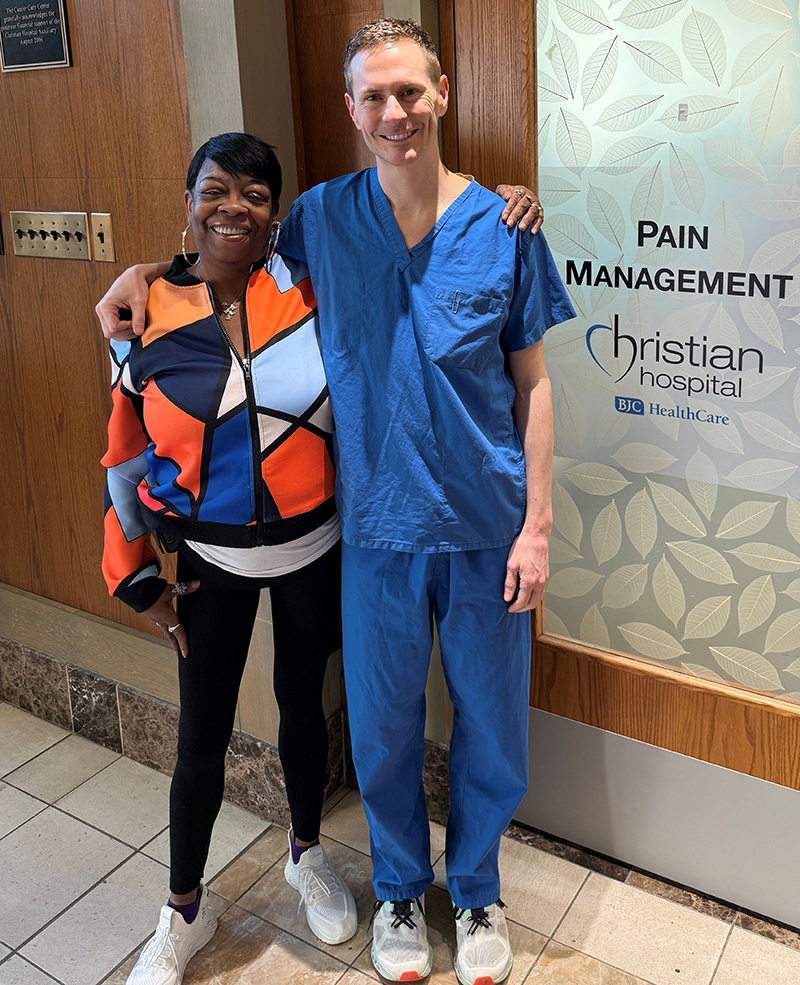Spinal Cord Stimulation Helps Diabetic Neuropathy Patient Get Active Again
Christian Hospital’s Pain Management Center eased Deirdre’s pain
2 minutesDeirdre Parnell was diagnosed with diabetes more than eight years ago. She then began experiencing pain in her feet, which spread to her legs and hands. Eventually, the pain grew so intense she had to take a leave of disability at work.

Deirdre was diagnosed with diabetic neuropathy, a form of nerve damage caused by diabetes. She spent thousands of dollars on various treatments. Nothing helped.
Deirdre was eventually referred to Chris Beuer, MD, at Christian Hospital’s Pain Management Center. He introduced the possibility of spinal cord stimulation as a form of treatment.
Spinal cord stimulation has historically been used to treat spine-based pain. However, with the latest iteration of spinal cord stimulators, diabetic neuropathy has been added as a treatable condition.
“There were a couple medications for diabetic neuropathy, but they didn’t typically work all that well,” Dr. Beuer says. “Spinal cord stimulators fill a void for those people who previously didn’t have good options for pain control.”
A spinal cord stimulator is a small, pacemaker-like device that is implanted under the skin and sends mild electrical pulses through thin wires called electrodes, which run up a patient’s spinal cord, disrupting the ability of the nerves to send painful signals.
Patients can test a temporary stimulator before deciding if they’d like to have a permanent one inserted. Deirdre’s temporary stimulator worked so well she didn’t want to take it out.
To install a permanent stimulator, surgeons don’t have to cut any bone or muscle. It takes about 45 minutes. Patients typically go home the same day without much recovery time and see quick results. Eighty to 90 percent of patients experience significant improvement with spinal cord stimulators, Dr. Beuer says.
Deirdre is now in that group. What used to be severe pain has faded significantly into a dullness that no longer stands in her way.
“I am never going to be entirely pain-free, but I don’t have to worry anymore,” she says. “I’m doing things I haven’t done in 10–15 years. I chase my 8-year-old grandson up and down the football field. I recently went for a long walk with a neighbor, and next thing I know, we were back at my apartment, no problem. I used to cry because there was nothing else to do. Now, I smile. I joke around. I’m back to being me.”
To schedule an appointment with the Pain Management Center, call 314-653-5228.
Recent News
Patient Story
Beating the Odds: A Pastor’s Journey Through Advanced, Lifesaving Heart Care
Patient Story
Healing Beyond the Surface
Patient Story
Before Life-Changing Spine Surgery at Christian Hospital, a Grandfathe
Patient Story
Chenitra Emergency Care
Patient Story
Christian Hospital Hybrid Room Procedures Save Lives
News